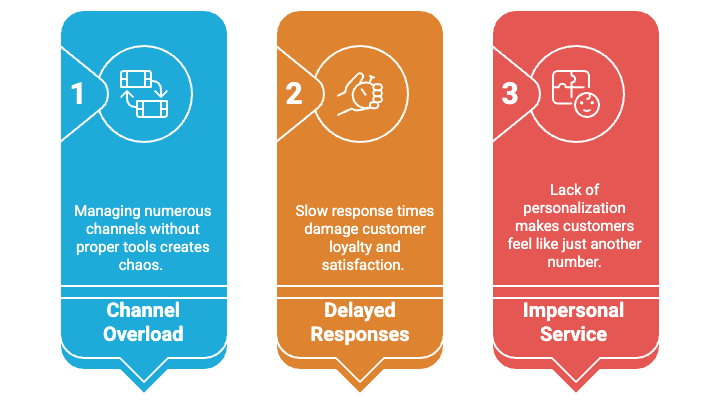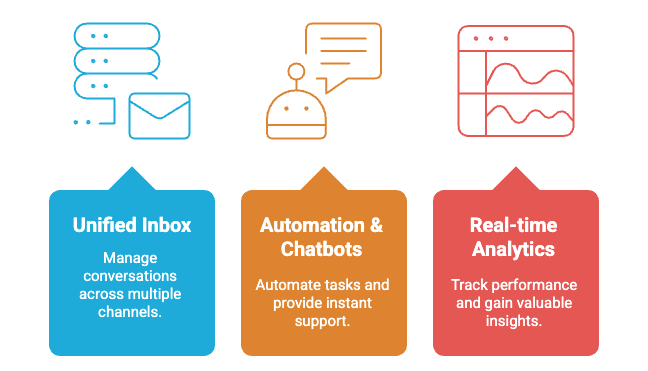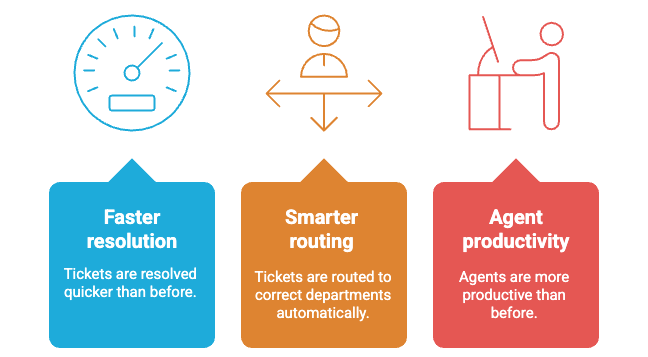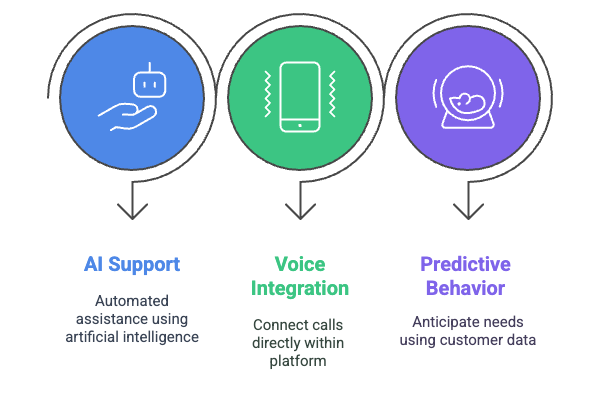Customer interaction management software: A proven guide for ecommerce success [2025]
Sneha Arunachalam
Aug 12, 2025

Shoppers these days expect way more from online stores. Did you know that 86% of consumers would pay extra just for a better experience? That's why customer interaction management software isn't just nice to have anymore — it's make-or-break for your ecommerce brand.
Think of it like this: your interaction platform is basically the face of your company. When 84% of online shoppers say customer service is essential to their buying decisions, what you're using to manage those conversations directly impacts whether they stick around or bounce to a competitor.
The right tools help you track what customers like, keep conversations flowing smoothly, and turn one-time buyers into loyal fans. Plus, they actually boost how many people complete checkout while cutting your shipping headaches.
In this blog, we’ll explore what makes a good customer interaction management software, the best tools available in 2025, latest trends shaping the industry, and explain why investing in the right customer interaction management software can make all the difference for your e-commerce business.
Why ecommerce brands struggle with customer interactions

Customer satisfaction with online stores keeps dropping. 68% of retailers reported drops in customer satisfaction in 2025. This isn't just a random blip. Three major headaches are making it nearly impossible for ecommerce brands to keep shoppers happy.
Too many channels, not enough tools
Today's customers bounce between touchpoints like they're channel surfing. They email you in the morning, tag you on social media at lunch, expect live chat help in the afternoon, and might still call you before dinner. This juggling act is driving support teams crazy.
When your tools don't connect, everything falls apart. Teams duplicate work, issues take forever to resolve, and customers get frustrated. Without the right system, you're stuck with:
- Different quality levels depending on which channel customers use
- Team members tripping over each other's responses
- Messages that contradict each other
- No clue which channels customers prefer tomorrow
Think about this — nearly half of sellers have burned through at least $1 million trying to connect these channels without the right tools. Plus, when you sell across multiple platforms, keeping inventory straight becomes a nightmare that can seriously damage your reputation.
Customer interaction management software fixes this mess by pulling all those conversations into one place. Your team sees everything, coordinates better, and delivers consistent quality no matter where customers reach out.
Slow response times hurt loyalty
Nobody waits patiently anymore — especially when they need help with something they're buying. The cost of dragging your feet? It's brutal:
53% of digital consumers will straight-up abandon their cart if you don't respond quickly. If you're pouring money into ads, that's basically watching your marketing budget burn.
Response speed directly impacts your bottom line. One apparel brand saw checkout completions jump 17% after cutting response times from 15 minutes to under 3 minutes. They didn't change prices, ads, or products — just answered customers faster.
Here's what shoppers really think: 83% feel stronger connections to brands that solve problems promptly, and a whopping 92% expect quick solutions when issues pop up. For younger buyers, 70% say response speed is make-or-break for their experience.
Every minute you make someone wait doesn't just annoy that person — it scares off other potential buyers too. A system that helps you respond lightning-fast across all channels isn't optional luxury anymore — it's survival gear.
Lack of personalization
Everyone knows personalization matters, but most stores still struggle with it. 71% of consumers expect personalized interactions, while 76% get frustrated when that doesn't happen.
The bar is sky-high now. 72% of consumers expect businesses to recognize them as individuals and know what they're into. But reality check — only 16% of product pages actually offer personalized experiences. That's a massive gap between what customers want and what they're getting.
The numbers tell the story:
- 78% of consumers say personalized content makes them more likely to buy again
- 76% point to personalized communications as a key reason they consider a brand
- 80% of shoppers are more likely to buy from brands offering personalized experiences
Here's the weird part — 67% of brands claim personalization is a top priority, but half of companies worldwide aren't putting resources behind it. The struggle is real — 50% don't have dedicated personalization support and 57% lack a unified audience strategy.
For stores willing to solve this, there's a gold mine waiting. Over the next five years, we're looking at a $2 trillion opportunity for ecommerce brands that get personalization right.
Good customer interaction management doesn't just patch these problems — it turns them into serious advantages. The right software brings all your communications together, speeds up responses, and delivers the personal touch customers crave.
What makes a good customer interaction management platform?

Ever wondered what separates the great customer interaction tools from the just-okay ones? After looking at dozens of options, we've spotted three features that really make the difference in how well these platforms perform in 2025.
Unified inbox and omnichannel support
Here's what matters most — bringing all those conversations together in one place. 61% of customers expect consistent experiences across channels, but trying to manage separate platforms creates headaches for everyone involved.
A solid unified inbox pulls together:
- Email, phone, chat, SMS, and WhatsApp messages
- Social media conversations from Facebook and Instagram
- Website chat and messaging app interactions
Think of it like having all your customer's stories in one book instead of scattered across different notebooks. Your team gets the complete picture every time — no more jumping between tabs or asking customers to repeat themselves.
The best part? Customers can start talking to you on Instagram and continue on email without missing a beat. They get that smooth, consistent experience they're looking for, no matter which door they come through to reach you.
Automation and chatbots
Let's face it — some customer questions come up over and over again. That's where automation shines in modern platforms.
Good automation handles two big things:
First, it tackles those repetitive tasks that eat up your team's day — sending confirmation emails, updating profiles, and writing up call notes.
Second, it gives customers the DIY options many actually prefer.61% of customers would rather solve simple problems themselves without waiting for help.
Today's AI chatbots aren't those clunky old things that barely understood basic questions. The new ones can:
- Gather customer details before any human steps in
- Pull answers from your knowledge base
- Personalize responses based on who they're talking to
- Know exactly when a human needs to take over
No wonder 71% of customers say these tools help them get faster answers. Plus, you could cut support costs by nearly a third.
Real-time analytics and tracking
You can't improve what you can't measure — and waiting weeks for reports just doesn't cut it anymore. Real-time analytics changes the game completely.
A quality platform shows you:
- Live dashboards that tell you what's happening right now
- Detailed stats on how messages perform from send to response
- Operational insights that track customer journeys
- AI that can tell when customers are getting frustrated
With these tools, you can see exactly what's working and what's not, right as it happens. No more making decisions based on last month's numbers when today's customers need attention now.
This kind of tracking also helps make sure you've got enough people ready when things get busy. Nothing kills customer trust faster than long wait times during your busiest hours.
The data tells you which channels your customers love, which messages actually work, and where your team might need a little extra coaching. That's how you keep getting better, one interaction at a time.
Top 6 Customer interaction management software for 2025
1. SparrowDesk
Best for: Fast-growing businesses that want a clean, modern support experience without the bloat.
If you're tired of clunky interfaces and juggling tools, SparrowDesk is a breath of fresh air. It brings all your customer conversations into one simple inbox. With AI agents instantly resolving 45% of customer requests, it’s built for speed—powered by smart automation and an AI copilot that helps, not hinders.
What you'll love:
- All-in-one inbox for every channel
- AI that helps you respond faster
- User-friendly with a clean interface
- A self-service portal customers actually use
2. Intercom
Intercom is a go-to for many SaaS and tech companies because it’s designed to engage customers right inside your product. Whether it’s onboarding new users, providing instant support, or automating common responses, Intercom makes these interactions feel seamless. It’s feature-rich and reliable, though the pricing can be on the higher side.
Key strengths:
- In-app messaging and chat
- Automation and bots for efficiency
- Personalized customer outreach
- Ideal for product-led growth companies
3. Kustomer
Kustomer offers a comprehensive view of each customer’s journey by combining all their interactions, purchases, and support history in one timeline. This makes it especially valuable for retail and e-commerce businesses that engage heavily through social media channels like Facebook and Instagram. It’s all about giving your agents the context they need to provide better service.
What stands out:
- Customer timelines consolidating all touchpoints
- Strong social media messaging integration
- Automated workflows to reduce manual tasks
- Great for brands with multi-channel customer engagement
4. Front
Front turns your inbox into a collaborative workspace, making it easier for teams to handle customer messages together. You can assign conversations, leave internal notes, and coordinate responses without confusion. It’s particularly useful for B2B companies where teamwork and clear communication are essential.
Why Front works well:
- Shared inbox for multiple channels
- Team collaboration features
- Prevents overlapping or duplicate replies
- Built for organized, high-touch support teams
5. Twilio Flex
Twilio Flex is a flexible, customizable platform designed for businesses with the resources to build their own tailored customer interaction system. It supports voice, chat, SMS, and more — but you’ll need developers to get the most out of it. It’s best suited for large or complex support operations that require a custom solution.
Ideal for:
- Businesses with technical teams
- High-volume or specialized support needs
- Organizations wanting full control over their setup
6. LiveAgent
For small businesses or teams on a budget, LiveAgent offers solid features covering email, live chat, social media, and even call support. While it may not have the polish of some newer platforms, it delivers reliable performance and covers all the basics without a steep learning curve or high costs.
What makes LiveAgent appealing:
- Comprehensive multi-channel support
- Affordable pricing for small teams
- Easy to implement and use
- Suitable for startups and small businesses
How these customer interaction management software improve ecommerce customer experience

Let's get real — the right customer interaction management software don't just tweak your support system, they completely transform how shoppers experience your brand. We've looked at tons of implementation data, and here's what jumps out: these systems deliver three game-changing improvements that hit your bottom line directly.
Faster ticket resolution
Nobody likes waiting around for answers. Research shows 90% of customers expect immediate responses when they have issues, with 60% defining "immediate" as 10 minutes or less. That's a pretty tall order, right?
Think of it like this: good customer interaction software is basically your 24/7 problem-solving team. These platforms let customers help themselves (which many actually prefer), cutting down ticket volume while speeding up answers. The numbers are pretty wild — when implemented correctly, AI-powered customer support can handle almost two-thirds of customer service tasks and up to 70% of contacts.
What does this mean for your response times? Companies using these platforms see ticket resolution times drop by up to 30%. That happens because:
- Tickets automatically zip to the right teams instantly
- AI chatbots handle the simple stuff without human help
- Knowledge bases serve up immediate answers to common questions
The business payoff is huge. Companies with quick resolution times see customer retention jump by up to 25%. Even more impressive? When you respond within an hour, you're seven times more likely to keep customers coming back for more purchases. That first message sets the tone.
Smarter routing and workflows
Ever noticed how traditional routing systems feel kind of... robotic? They use rigid rules that just can't handle the messy, human nature of customer questions. Modern platforms flip this approach completely.
Here's a quick example: these new systems use AI to match shoppers with the perfect agent for their specific problem. The technology analyzes hundreds of data points to find the best match by:
- Calculating agent scores across different issues using past case data
- Assessing who's best at solving specific problems
- Ranking agents based on those calculated scores
This smart approach kills the headaches of manual routing — all that repetitive, time-consuming work that costs a fortune to scale. Better yet, it prevents those frustrating bottlenecks when everyone gets sent to one department even though other teams could help them just as easily.
The business impact? It's crystal clear. Good routing directly improves your key metrics like handle time and first-contact resolution. Some systems even run automatic training updates to keep improving their matching accuracy over time.
Better agent productivity
Your support team's productivity totally affects how satisfied and loyal your customers feel. The right software gives your agents tools to work smarter without cutting corners on quality.
A unified workspace is probably the biggest game-changer here. It brings together all those communication channels and gives agents the full customer story. The benefits are massive:
- No more tab-switching between a dozen different apps
- Instant access to customer history and what they like
- Real-time conversation summaries (no more note-taking!)
- Suggestions for what to do next to solve the problem
These tools eliminate all those time-sucking manual tasks like tagging tickets, drafting responses, and setting up workflows. So your team can focus on solving the tricky problems instead of drowning in admin work.
These platforms also make training and skill development way easier. Well-trained agents solve problems faster, and these systems include data tools that track performance and service metrics. It's a continuous improvement cycle that keeps making your customer interactions better and better.
What's next: Trends in customer interaction management

The customer interaction world is changing faster than most of us can keep up with. Looking ahead, three big shifts are completely changing how online stores connect with shoppers. Let's take a peek at what's coming.
AI-powered support agents
Remember those clunky chatbots that could barely understand basic questions? Those days are gone. Today's AI support has grown up — these systems now handle complex issues that used to require a human on the other end.
What's really impressive is how these new AI agents can actually sense when a customer is frustrated and adjust their tone accordingly. No more robotic responses that make angry customers even angrier.
The numbers tell the story here. A whopping 79% of businesses report happier customers after switching to emotionally intelligent AI systems. And these aren't just for chat anymore — they work across calls, emails, and social platforms to create that consistent feel customers crave.
Think of it like this: older AI systems were like security guards who could only say "yes" or "no." Today's AI is more like a concierge who remembers your preferences and anticipates what you might need before you even ask.
Voice and video integration
Voice is becoming huge in customer interactions. Currently, 41% of adults use voice search every single day, and that number keeps climbing.
Smart speakers aren't just for playing music anymore — they've become legitimate customer service channels. Shoppers can check their order status or even make purchases through simple voice commands. For online stores, this opens up totally new ways to reach customers during cooking, driving, or anytime their hands are busy.
Video support is taking off too, with some pretty incredible results for brands that jump in early:
- 91% boost in customer satisfaction
- 89% increase in solving problems on the first call
- 85% fewer returns for complicated products
Video basically brings that in-store personal shopping experience right to online retail. It's like having your best sales associate available through a screen, showing products and answering questions in real-time.
Predictive customer behavior
Here's where things get really interesting — the future of customer interaction isn't just about answering questions, it's about prediction. Smart systems can now spot patterns that suggest a customer might:
- Be thinking about canceling
- Need help with a product
- Be ready for an upgrade
- Have shipping questions
This shift to proactive support is totally changing the game. Instead of waiting for problems to pop up, these systems spot and address potential issues before customers even realize they exist.
These systems are getting better at telling the difference between someone who's just browsing and someone who's ready to buy. This helps brands offer the right help at the right time without coming across as pushy or creepy.
All these changes point to a future where customer interactions become way more personal, proactive, and seamless across every touchpoint. The stores that win won't just be the ones with the best products — they'll be the ones that make customers feel most understood.
Conclusion
So now you know, customer interaction management software isn't just another fancy tool for your ecommerce toolkit. Throughout this guide, we've seen how the right CIM systems tackle those daily headaches that drive online retailers crazy.
Think about what these platforms actually do for you. They wrangle all those scattered communication channels into one manageable place. They slash response times dramatically — which matters big time when 53% of shoppers will ditch their cart if you don't get back to them quickly. Plus, they deliver those personal touches that 78% of customers say keep them coming back for more.
What makes a customer interaction management software solution actually worth your money? Three things: a unified inbox that brings everything together, smart automation that handles the routine stuff, and real-time analytics that show you what's working and what's not.
Your specific business needs should drive which platform you choose. Maybe SparrowDesk fits your overall strategy, or perhaps Aircall makes more sense if voice communication is your priority. Either way, the impact on how customers experience your brand will be huge. But remember — even the fanciest software won't save you without a solid implementation plan.
The real magic happens when your customer interaction management transforms how shoppers see your brand. Faster ticket solutions, smarter workflows, more productive agents — these improvements directly boost your conversion rates and customer loyalty.
As AI gets smarter, voice commerce grows, and prediction capabilities get more sophisticated, your approach to customer interactions needs to evolve too. The brands that'll win tomorrow are the ones jumping on these tools today while keeping an eye on what's coming next.
Your customers totally expect amazing service everywhere they interact with you. So here's the real question: can you really afford to run your business without proper customer interaction management software? We don't think so.
Quick summary: Customer interaction management software: Essential for ecommerce success
With 86% of consumers willing to pay extra for better experiences, customer interaction management software has become critical for ecommerce brands. When 84% of shoppers consider customer service essential to purchasing decisions, the right interaction platform directly impacts whether customers stay or leave for competitors.
- Major Pain Points: Ecommerce brands struggle with disconnected channels, slow response times (53% abandon carts without quick responses), and lack of personalization (71% expect it, but only 16% of product pages deliver)
- Essential Features: Top platforms offer unified inboxes, AI-powered automation, and real-time analytics
- Top Solutions: SparrowDesk, Intercom, Kustomer, Front, Twilio Flex, and LiveAgent each serve different business needs
- Proven Results: Faster ticket resolution (30% improvement), smarter routing systems, and boosted agent productivity
Customer interaction management software transforms customer experiences through unified communications, automated responses, and personalized interactions. As AI advances and voice commerce grows, brands investing in these tools today gain competitive advantages. With customers expecting amazing service across all touchpoints, proper customer interaction management isn't optional—it's essential for ecommerce survival and growth.
Frequently Asked Questions
While help desks are often focused on resolving support tickets, CIM software takes a broader approach. It’s built to manage every kind of customer interaction — not just issues. That includes pre-sale questions, post-purchase follow-ups, and proactive outreach across multiple channels.
Not at all. Many CIM platforms are designed with scalability in mind, meaning even small teams can benefit. There are affordable options out there that offer powerful tools without the enterprise-level complexity or price tag.
In 2025, we’re seeing more AI-driven suggestions for agents, smarter automation (like intent-based routing), tighter integrations with e-commerce platforms like Shopify, and more visual self-service options like interactive help centers. It’s all about making support faster and more intuitive — for both teams and customers.
Look for deep integrations with your storefront (like Shopify or WooCommerce), support for high-volume messaging platforms (like Instagram and WhatsApp), and features like order lookups or refund tracking right inside the conversation view.
Key metrics include response time reduction, first-contact resolution rates, customer satisfaction scores, cart abandonment rates, and agent productivity. Most platforms provide built-in analytics dashboards.
